 Were someone to ask me to name my most favorite winter pots ever, no doubt this pair would immediately come to mind. These varnished Belgian oak boxes put together with precisely spaced countersunk screws quietly remind me of a double breasted band uniform replete with brass buttons; dignified and all put together. The noble fir and douglas fir greens are generous and wide. The pale bleached willow sticks have a collar of natural stick stacks that have absorbed moisture from the air, and arched over-naturally. These pots have the most fabulously artless hairdos. Bottlebrush snowflakes hang here and there. Just enough structure meets weathering natural material. The good proportions of top to bottom please me.
Were someone to ask me to name my most favorite winter pots ever, no doubt this pair would immediately come to mind. These varnished Belgian oak boxes put together with precisely spaced countersunk screws quietly remind me of a double breasted band uniform replete with brass buttons; dignified and all put together. The noble fir and douglas fir greens are generous and wide. The pale bleached willow sticks have a collar of natural stick stacks that have absorbed moisture from the air, and arched over-naturally. These pots have the most fabulously artless hairdos. Bottlebrush snowflakes hang here and there. Just enough structure meets weathering natural material. The good proportions of top to bottom please me.
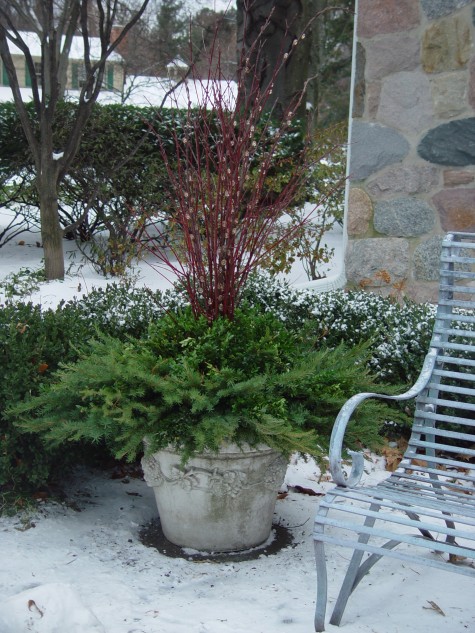 Though I personally have a mind to fend off the winter vigorously, I am lucky to have clients who do not mind the stillness of the winter season. They tell me: quiet, please. Represent me softly-naturally. Douglas fir and boxwood make such a great mix. A few stems of acrylic pussy willow adds just a little sparkle to the red twig.
Though I personally have a mind to fend off the winter vigorously, I am lucky to have clients who do not mind the stillness of the winter season. They tell me: quiet, please. Represent me softly-naturally. Douglas fir and boxwood make such a great mix. A few stems of acrylic pussy willow adds just a little sparkle to the red twig.
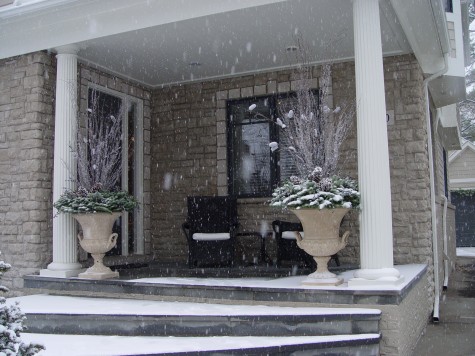 Intermittent snow in December dusts everything with white. This is beautiful winter weather-not the hit you over the head winter that is to come. The winter sculpture in this pair of pots demands nothing and expresses everything of a world gone silent.
Intermittent snow in December dusts everything with white. This is beautiful winter weather-not the hit you over the head winter that is to come. The winter sculpture in this pair of pots demands nothing and expresses everything of a world gone silent.
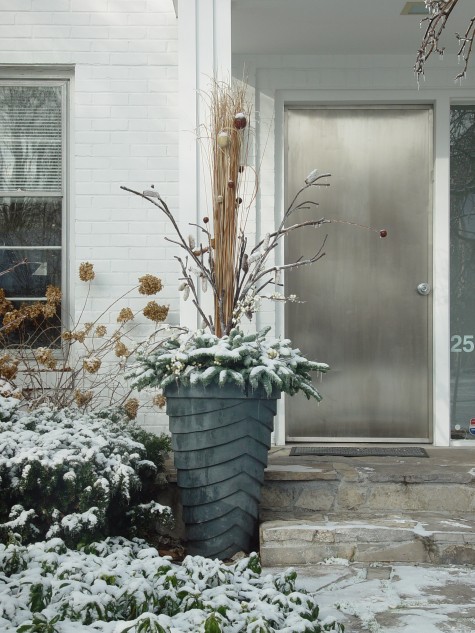 This client refurbished her front door in brushed stainless steel at my recommendation. This very contemporary Francesca del Re pot, and its winter dress, simply expresses the colors and shapes of her season. The color echoes what already exists in her hydrangeas and yews.
This client refurbished her front door in brushed stainless steel at my recommendation. This very contemporary Francesca del Re pot, and its winter dress, simply expresses the colors and shapes of her season. The color echoes what already exists in her hydrangeas and yews.
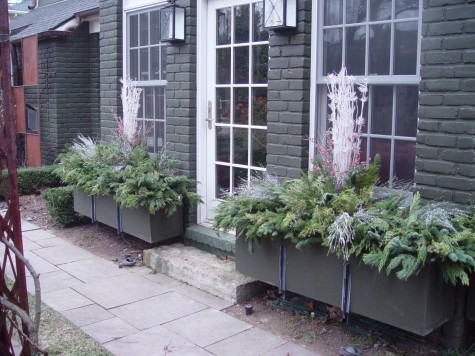
Big window boxes can speak softly, despite their size. Brushy, with pale accents-this is a choice. My recommendation? Decide in advance the feeling you wish to convey, and choose the materials accordingly. Accidents of nature are sometimes astonishingly good-other times, not so good. If I can spot what has gone wrong, chances are it can be fixed. Sometimes I have to see to know.
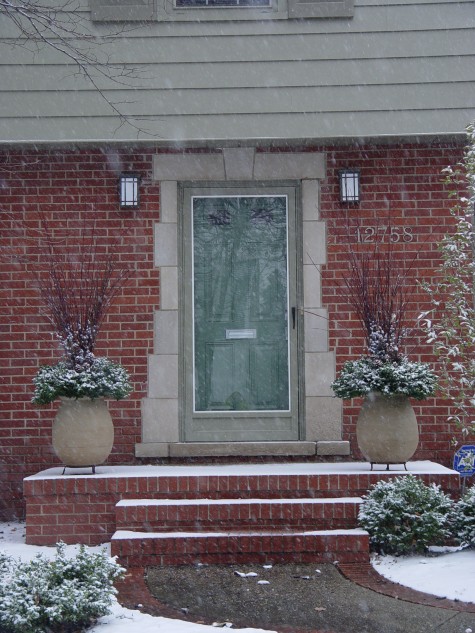 This pair of English stoneware pots from the Hode Pottery are frostproof-no need to bring them in. The simple trivet stands reveal the shape of the pots from top to bottom. A pot with a base larger than its opening benefits from a treatment like this. Twigs, cones and boxwood make for a dressy, not noisy display.
This pair of English stoneware pots from the Hode Pottery are frostproof-no need to bring them in. The simple trivet stands reveal the shape of the pots from top to bottom. A pot with a base larger than its opening benefits from a treatment like this. Twigs, cones and boxwood make for a dressy, not noisy display.
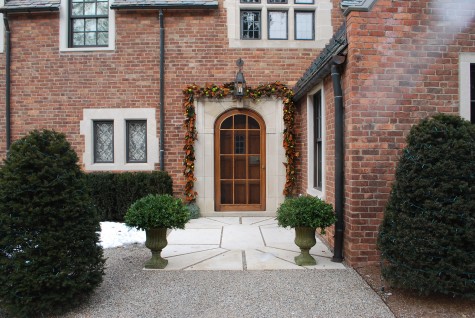
Growing boxwood in pots is not easy. They need attention all year round. They may need watering in a January thaw, and by March, regular water. The rootball of a well-grown boxwood is not much smaller than the top. They will only prosper in pots large enough to give their roots room to grow. Pots this size are much better filled with cut boxwood stuffed into a foam form. All the beauty of boxwood without so much responsibility.

I like everything about nature’s palette. The blues and greys of the stone, steel and snow. Twig, stem and leaf brown, with a dash of evergreen. What I see here is just enough celebration to take the chill off.
 The watch I have had strapped to my wrist my entire working life is a marvel. In spite of the heat sweat water and dirt, it churns on. This little workhorse enables me to to organize and schedule any number of things. Being off or behind schedule can be trouble; ahead of schedule-this I like. Around January 15, I take it off for 6 weeks, and let my internal clock handle the day. Landscapes have long been host to various mechanisms for telling time. The old clock face pictured above was salvaged from a monumental public timepiece in a Belgian town square, due for refurbishment after many years of service.
The watch I have had strapped to my wrist my entire working life is a marvel. In spite of the heat sweat water and dirt, it churns on. This little workhorse enables me to to organize and schedule any number of things. Being off or behind schedule can be trouble; ahead of schedule-this I like. Around January 15, I take it off for 6 weeks, and let my internal clock handle the day. Landscapes have long been host to various mechanisms for telling time. The old clock face pictured above was salvaged from a monumental public timepiece in a Belgian town square, due for refurbishment after many years of service.  Sundials vastly predate the invention of watches and clocks; ancient cultures told time via the position of the sun in the sky. The device needed to be positioned in a sunny place in the landscape. As they are big chunky scientific instruments, people constructed them to be beautiful, as well as utilitarian. The dial portion of a sundial is small and unassuming. A flat plate was engraved or otherwise etched with a clock face. The triangular shaped gnomen set into the plate would cast a shadow from the sun, onto a different mark on the plate for every hour, or portion of an hour, of any given sunny day.
Sundials vastly predate the invention of watches and clocks; ancient cultures told time via the position of the sun in the sky. The device needed to be positioned in a sunny place in the landscape. As they are big chunky scientific instruments, people constructed them to be beautiful, as well as utilitarian. The dial portion of a sundial is small and unassuming. A flat plate was engraved or otherwise etched with a clock face. The triangular shaped gnomen set into the plate would cast a shadow from the sun, onto a different mark on the plate for every hour, or portion of an hour, of any given sunny day.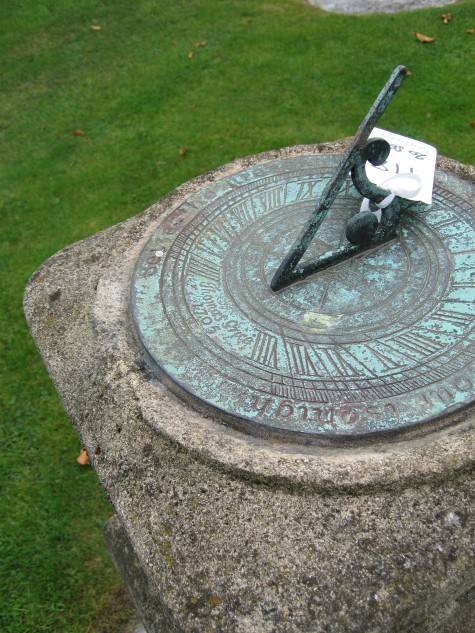 The engraving on the plates was often quite elaborate. This plate is engraved with the hours in Roman numerals; each numeral is further subdivided into increments of an hour. This plate is a beautiful drawing about time. The name and date- Thomas Grice,1705 might refer to the artist who engraved the plate, or the person’s garden to whom this sundial belonged.
The engraving on the plates was often quite elaborate. This plate is engraved with the hours in Roman numerals; each numeral is further subdivided into increments of an hour. This plate is a beautiful drawing about time. The name and date- Thomas Grice,1705 might refer to the artist who engraved the plate, or the person’s garden to whom this sundial belonged. 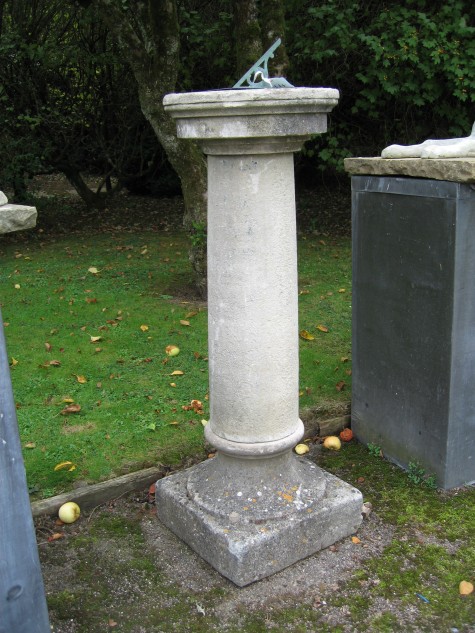 As the sundial needed to be placed in a level spot with the gnomen, or needle, set due north when the sun was directly overhead, the base needed to be sturdy, stable, and equally as lovely as the plate. This handcarved stone baluster sets the plate at 50 inches above grade-right at my eye level. Inscribed in spidery script, ” Let others tell of storms and showers/I’ll only tell your sunny hours”.
As the sundial needed to be placed in a level spot with the gnomen, or needle, set due north when the sun was directly overhead, the base needed to be sturdy, stable, and equally as lovely as the plate. This handcarved stone baluster sets the plate at 50 inches above grade-right at my eye level. Inscribed in spidery script, ” Let others tell of storms and showers/I’ll only tell your sunny hours”.  As a time telling device, a sundial has become obsolete. As a garden ornament, they are unmatched for their quiet beauty and dignity. They are as at home in a kitchen garden as a formal boxwood parterre. They refer to the ephemeral nature of life, and the repeating cycle of nature. I have never seen them made of materials that did not suggest permanence. Modern makers have expanded upon the traditional materials to include stainless steel, glass and mirror, but my favorites are the pieces dating from an age when they were still in use.
As a time telling device, a sundial has become obsolete. As a garden ornament, they are unmatched for their quiet beauty and dignity. They are as at home in a kitchen garden as a formal boxwood parterre. They refer to the ephemeral nature of life, and the repeating cycle of nature. I have never seen them made of materials that did not suggest permanence. Modern makers have expanded upon the traditional materials to include stainless steel, glass and mirror, but my favorites are the pieces dating from an age when they were still in use. 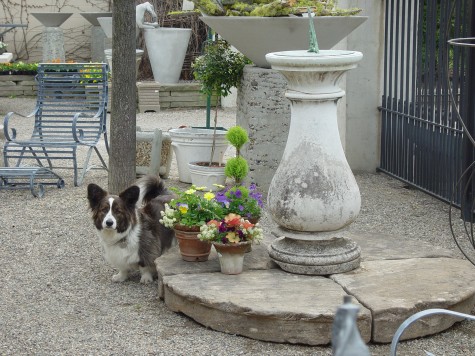
 This collection of English sundials vary greatly in their details, but all of them are remarkably intact, considering their age, and exposure to weather. I am sure they will all find a new home in a treasured garden space.
This collection of English sundials vary greatly in their details, but all of them are remarkably intact, considering their age, and exposure to weather. I am sure they will all find a new home in a treasured garden space.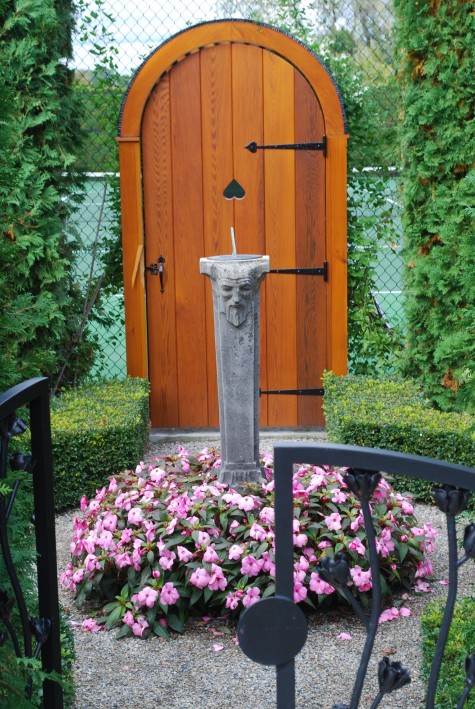
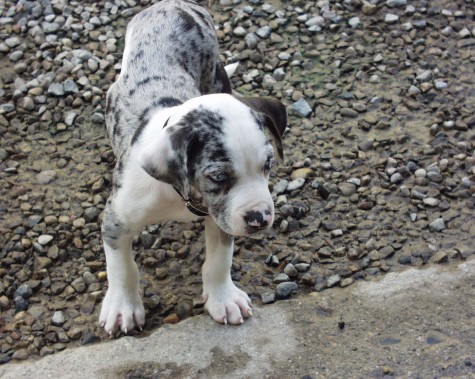
 Troy is a gardener of exceptional ability, in addition to his gift as a sculptor. Growing up on a farm on the west side of Michigan, he grew a giant vegetable garden, ran a blueberry farm, did surveying, hunted, fished, and walked the woods. He came by his skills as a naturalist, naturally. He sculpted for me in concrete; this two-headed fox bench is his work. Annie went everywhere with him, including to the studio.
Troy is a gardener of exceptional ability, in addition to his gift as a sculptor. Growing up on a farm on the west side of Michigan, he grew a giant vegetable garden, ran a blueberry farm, did surveying, hunted, fished, and walked the woods. He came by his skills as a naturalist, naturally. He sculpted for me in concrete; this two-headed fox bench is his work. Annie went everywhere with him, including to the studio. 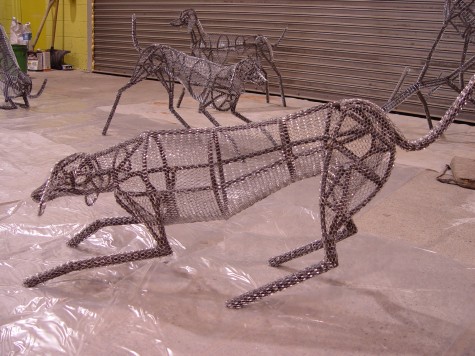
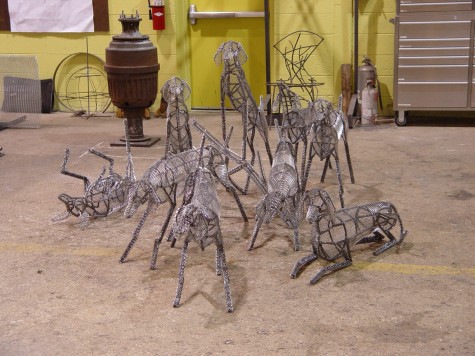 These very gestural and simple structures provide strength for the concrete and mortar to come. He squishes and packs concrete around these frames; the strength that a garden sculpture needs first and foremost, comes first. But I could tell from these frames I was going to like what came next. The outside mortar layer he hand carves.
These very gestural and simple structures provide strength for the concrete and mortar to come. He squishes and packs concrete around these frames; the strength that a garden sculpture needs first and foremost, comes first. But I could tell from these frames I was going to like what came next. The outside mortar layer he hand carves. 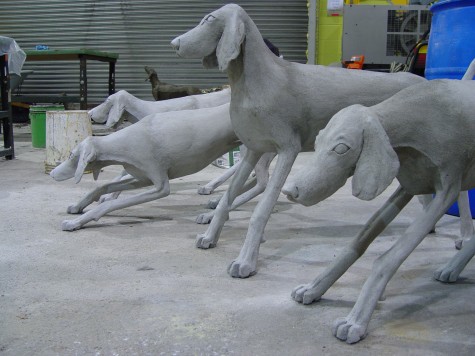 I was not prepared for how much I liked them. His sculptures of hounds are not about a biologically correct reproduction, they are about the heart and soul of his hound Annie. I was astonished by how much energy, motion and fluidity he managed to wring from a marriage of steel, and hundred pound sacks of concrete. This explication aside, these hounds won me over.
I was not prepared for how much I liked them. His sculptures of hounds are not about a biologically correct reproduction, they are about the heart and soul of his hound Annie. I was astonished by how much energy, motion and fluidity he managed to wring from a marriage of steel, and hundred pound sacks of concrete. This explication aside, these hounds won me over.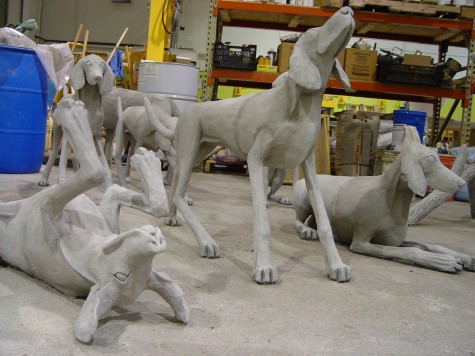 One hound was on his back, sunning and scratching, in the garden. Another was howling at the moon as if he had ten minutes to live. Yet another was tentatively down, those back legs were tucked under in such a position he could be cruising at a second’s notice.
One hound was on his back, sunning and scratching, in the garden. Another was howling at the moon as if he had ten minutes to live. Yet another was tentatively down, those back legs were tucked under in such a position he could be cruising at a second’s notice. This sculpture makes clear the legs that make for balance, and the legs that carry the weight. The position of the ears suggest this hound just shook his head, and looked up towards the moon. Most garden sculpture leaves me cold; these hounds are right at home in a landscape.
This sculpture makes clear the legs that make for balance, and the legs that carry the weight. The position of the ears suggest this hound just shook his head, and looked up towards the moon. Most garden sculpture leaves me cold; these hounds are right at home in a landscape. There was some discussion with Troy regarding sculpture that relies on the environment to be complete. He said, “don’t give me the history, just tell me what you need”. So ok fine, I asked him for a hound barking up a tree-the tree would be supplied by whomever took this barking dog home. She does have a good tree, and this hound has a good home.
There was some discussion with Troy regarding sculpture that relies on the environment to be complete. He said, “don’t give me the history, just tell me what you need”. So ok fine, I asked him for a hound barking up a tree-the tree would be supplied by whomever took this barking dog home. She does have a good tree, and this hound has a good home. 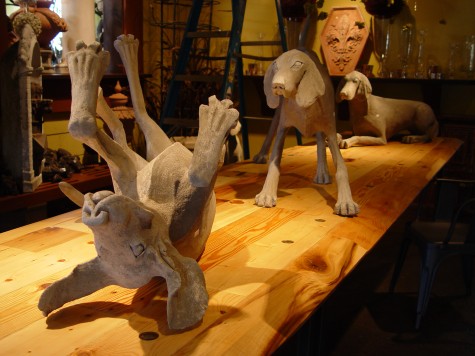 Troy’s sculptures of hounds could be in or out, up or down, on a sidewalk, in a bed, on a wall. I have placed 16 of them; they all moved away from me. When the garden wanes, I think about how much I value the sculpture that enchants me, all year long. His sculpture-creature comfort.
Troy’s sculptures of hounds could be in or out, up or down, on a sidewalk, in a bed, on a wall. I have placed 16 of them; they all moved away from me. When the garden wanes, I think about how much I value the sculpture that enchants me, all year long. His sculpture-creature comfort.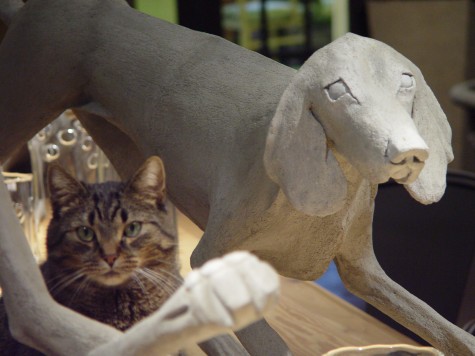
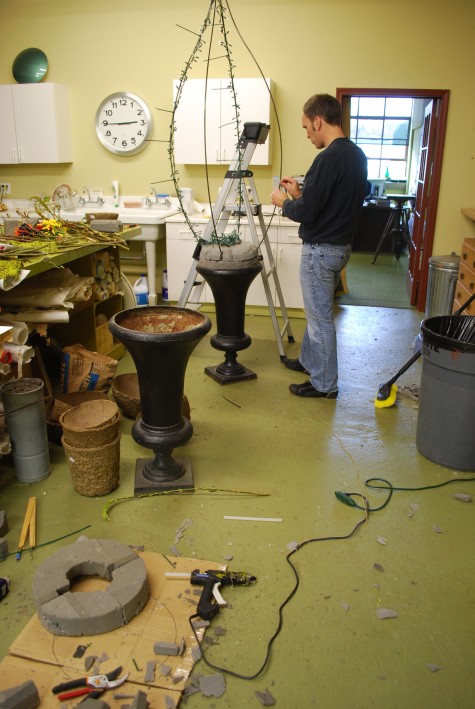 Our entire method of sturdily constructing an arrangement for a winter pot is predicated on one concept-you have to create the roots, and the trunk. I rarely worry about my summer pots going out of kilter. The roots of the plant secure them to the soil; plants grow upwards, towards the sun. I do not have that luxury in the winter, and Michigan has more than its fair share of stormy winter weather. So the mechanics of fastening all the materials is really important to the longevity and beauty of the piece. Tall skinny pots like these get lots of gravel in the bottom; a large centerpiece can be a big sail in disguise, just waiting for a decent wind to get airborne. We then construct a form in which to secure all the materials-glued up with industrial strength hot melt glue-that sits tight in the container. A loosely fitting form is just asking for trouble. If you have ever tried standing up in a pair of ice skates that do not lace up tight over your ankles, you know exactly what I am talking about.
Our entire method of sturdily constructing an arrangement for a winter pot is predicated on one concept-you have to create the roots, and the trunk. I rarely worry about my summer pots going out of kilter. The roots of the plant secure them to the soil; plants grow upwards, towards the sun. I do not have that luxury in the winter, and Michigan has more than its fair share of stormy winter weather. So the mechanics of fastening all the materials is really important to the longevity and beauty of the piece. Tall skinny pots like these get lots of gravel in the bottom; a large centerpiece can be a big sail in disguise, just waiting for a decent wind to get airborne. We then construct a form in which to secure all the materials-glued up with industrial strength hot melt glue-that sits tight in the container. A loosely fitting form is just asking for trouble. If you have ever tried standing up in a pair of ice skates that do not lace up tight over your ankles, you know exactly what I am talking about.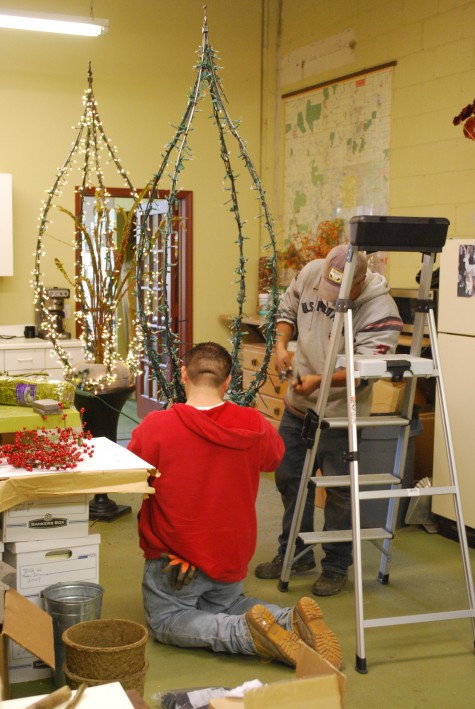 These pots will have lights in the vertical dimension; a steel form provides stability as light strings are heavy. They also make it possible to cleanly and crisply mimic a geometric form. As light strings shapes are governed by gravity, a rigid form insures they will be representing the form you choose for them today, next March.
These pots will have lights in the vertical dimension; a steel form provides stability as light strings are heavy. They also make it possible to cleanly and crisply mimic a geometric form. As light strings shapes are governed by gravity, a rigid form insures they will be representing the form you choose for them today, next March.  Winding the lights around a form is time consuming. It also makes the removal of the lights tedious. Zip ties make for an easy in and easy off. It’s also easy to spot in the above picture how close we space those zip ties; the closer, the better. Light string wires have strong kinks and curves when they come out of the package, but droop they will, given time. They do not hold a graceful curve on their own; we are generous with the fasteners. The centerpiece is set through a hole in the center of the form; a stout bamboo stake at the center of the arrangement goes far enough down into the pot to insure it stays vertical. There is something so wrenching about a listing centerpiece-who needs that in the winter?
Winding the lights around a form is time consuming. It also makes the removal of the lights tedious. Zip ties make for an easy in and easy off. It’s also easy to spot in the above picture how close we space those zip ties; the closer, the better. Light string wires have strong kinks and curves when they come out of the package, but droop they will, given time. They do not hold a graceful curve on their own; we are generous with the fasteners. The centerpiece is set through a hole in the center of the form; a stout bamboo stake at the center of the arrangement goes far enough down into the pot to insure it stays vertical. There is something so wrenching about a listing centerpiece-who needs that in the winter?  The fantail willow is set into the form based on a determination of the front elevation. When pots are placed such that they can be seen from all sides, we work in the round. As the form will be covered in a skin of lichen mat, the form is shaved into a rounded shape.
The fantail willow is set into the form based on a determination of the front elevation. When pots are placed such that they can be seen from all sides, we work in the round. As the form will be covered in a skin of lichen mat, the form is shaved into a rounded shape.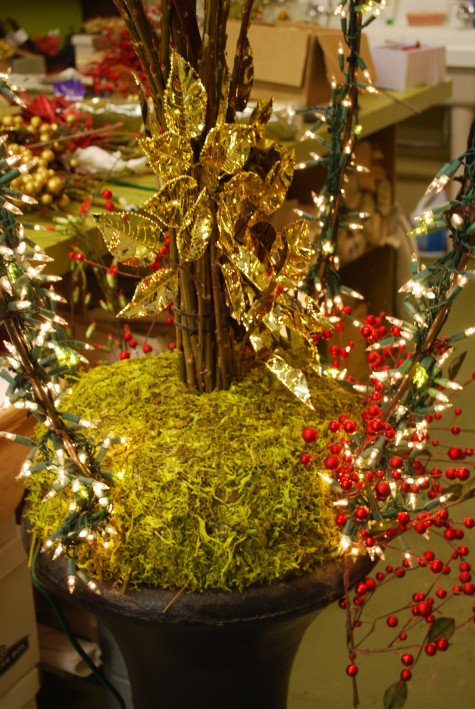 Once the form is covered in the lichen, we add a little icing to our lichen cake-just for the holidays. Gold leaves and a luminous red berry garland-yummy. These elements can be removed after the first of the year, so the pots look good throughout the winter. A client can use the lights in the winter-or not. The topiary form has a decidedly dressy look to it, with the added attraction of absolutely no maintenance. It will still look fine come next April, provided the construction is sound.
Once the form is covered in the lichen, we add a little icing to our lichen cake-just for the holidays. Gold leaves and a luminous red berry garland-yummy. These elements can be removed after the first of the year, so the pots look good throughout the winter. A client can use the lights in the winter-or not. The topiary form has a decidedly dressy look to it, with the added attraction of absolutely no maintenance. It will still look fine come next April, provided the construction is sound. 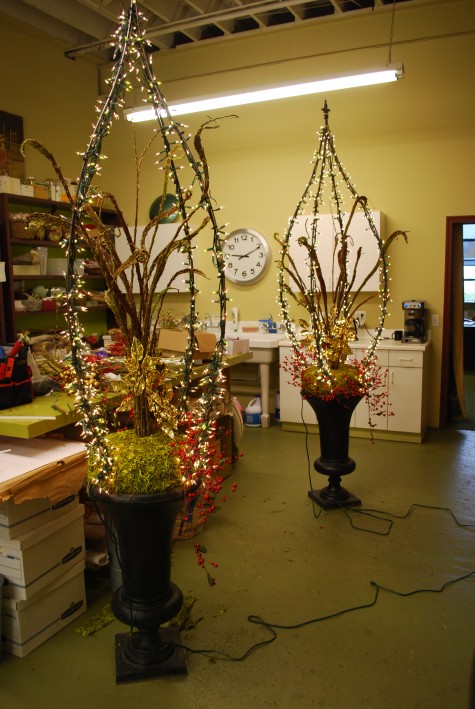 Getting the installation to match in a pair of pots is harder than you think. I try to work on pairs side by side. Some pairs of pots that demand a very formal arrangement, I make sure that one person does both. Everyone’s eye and hand is noticeably all their own. My rule of thumb-I work on the second pot, never taking my eyes off the first.
Getting the installation to match in a pair of pots is harder than you think. I try to work on pairs side by side. Some pairs of pots that demand a very formal arrangement, I make sure that one person does both. Everyone’s eye and hand is noticeably all their own. My rule of thumb-I work on the second pot, never taking my eyes off the first.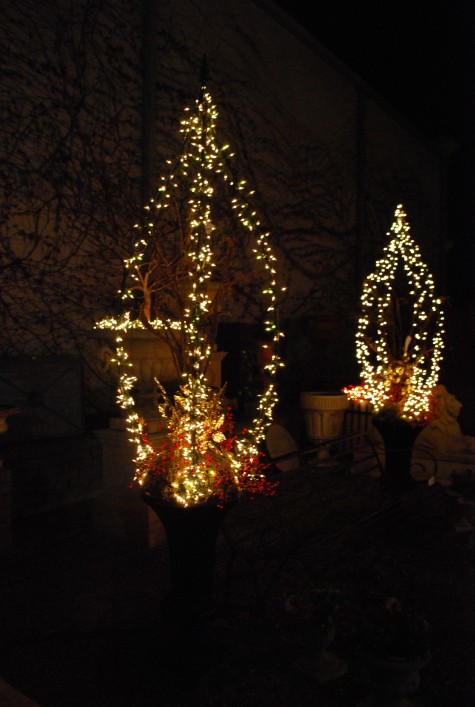
 Your winter pots are the best they will ever be, the first day they are done. Unlike a landscape that fills out, and blossoms with age, there is no growing involved. They need to be constructed tall, wide, and robust from the beginning. The winter is a season that can handle a little unedited excess, with a dash of over the top sparkly, with aplomb.
Your winter pots are the best they will ever be, the first day they are done. Unlike a landscape that fills out, and blossoms with age, there is no growing involved. They need to be constructed tall, wide, and robust from the beginning. The winter is a season that can handle a little unedited excess, with a dash of over the top sparkly, with aplomb.